Inviting students to plan for and facilitate discussions can have the effect of, as Tim McCarthy puts it, “provoking robust debate.” Though Tim McCarthy plays an integral role in class discussions, students themselves are responsible for leading the majority of classes, all of which are discussion-based. McCarthy refers to this exercise as a “provocation.” Leading such “provocations” affords student facilitators powerful, pedagogical perspectives while challenging them to participate more broadly in classroom discourse. In this video, McCarthy walks viewers through the intentional planning, designing, scaffolding, and assessing that goes into this ambitious, student-centered exercise.
Designing, scaffolding, and assessing student discussion leadership
Instructor
Timothy Patrick McCarthy, Lecturer on History and Literature
Student Group
Undergraduate/Graduate
School
Harvard College
Course
Stories of Slavery & Freedom
Group Size
16 students
- Model first. Before you ask students to lead the discussion, demonstrate how you would do it. While leading the discussion, step out of the role to draw attention to certain moves.
- Meet with student “provokers” before class to make a plan. Help them narrow down their ideas to those that might best ignite conversation.
- Be flexible. Some provocations might fall flat; others might lead to robust conversation. Plan for either.
- Take notes while students lead the discussion and use them to provide feedback to the “provokers” after class. Using a rubric will help you clarify what you are looking for and articulate how students could improve their discussion facilitation.
- One study shows that when afforded opportunities to lead as instructors or discussion facilitators, students report rates of higher satisfaction and emotional investment in their learning processes (Kurczek & Johnson, 2014)
- According to Mills, provocations can be used to initiate active learning in classrooms. Provocations can be used to help students examine their assumptions and, as a result, reach conclusions with logical foundations (1998).
- Sweet and colleagues propose simultaneous reporting as one approach to coordinate discussions. In simultaneous reporting the instructor designs questions where students have to make a choice or take a stance on an issue. Once students have made up their mind about their stance, they compare the choices they have made to the choices of their peers. Finally, students need to be able to explain the reasoning for their choices (2008). Although simultaneous discussion is a different approach than the instructional move described by Professor McCarthy, there are parallels between the two approaches in that they rely on student contributions to “provoke robust debate.”
- Thiw webpage from Harvard's Derek Bok Center for Teaching and Learning describes how another Harvard professor approaches student discussion leadership
- A professor at Seattle Pacific University discuss his experiences handing the reins over to students to lead classroom discussions in the Faculty Focus blog




